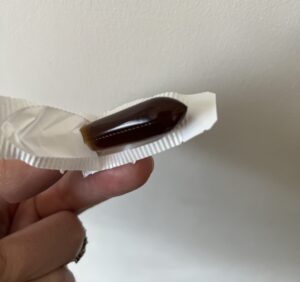What to do when Thrush and BV don’t go away
Imagine this scenario – you’ve been getting symptoms such as vulval itching and redness so you treat it with an over-the-counter thrush cream. The symptoms go. Must have been thrush, right?
It happens again later, but this time the treatment doesn’t work. So you try something else – maybe a pessary or an oral antifungal. Still getting symptoms…
Eventually, you get a swab from your GP, but the results don’t show anything definitive.
So you do a bit of research and decide to go on a strict anti-Candida diet and take several strong natural products that wipe everything out.
But now your gut’s feeling off, you’re anxious about everything you’re eating, and somehow you’re no closer to answers.
You go back to your doctor, and this time you’re given an antidepressant.
How did you end up here!?
Now take this story, and swap out thrush for recurrent UTIs, or BV, or interstitial cystitis. It’s a common journey for so many people, and it can be incredibly frustrating when symptoms keep recurring and you’re left without clear answers. Sometimes things do get picked up early and treatment is straightforward – but often I hear variations of this story, where people don’t fully know what’s causing their symptoms, or they’re led to believe it’s just something they have to live with. Others are placed on long-term medications they don’t feel comfortable with or are never told there may be an underlying imbalance.
A different approach –
When looking into vaginal microbiome health it’s important to have a good idea what you’re working with.
Most people are familiar with the classic symptoms of Candida/thrush – itching, redness, discharge. But sometimes it can present in less typical ways – for example, with only skin irritation or splitting, and no discharge at all. And importantly, Candida is just one type of imbalance. There are many microbes that can disrupt vaginal health – including bacteria linked to BV or chronic UTIs, and others that can trigger inflammation or discomfort without a clear “infection.”
So how do you find out what the cause is?
First and foremost we look at signs and symptoms. The colour, texture, sensations and odour of vaginal discharge can be very informative. Then we can narrow down whether the environment is too acid or alkaline, something that has a big impact on determining what sort of microbes can grow.
After examining symptoms, we can look at vaginal pH – an easy thing you can do at home to monitor the fluctuates from day to day. Vaginal pH is a good indicator of whether the condition is bacterial or fungal, and can show changes before symptoms appear.
A typical swab performed by the GP can also provide a lot of insight. Things like the presence of clue cells, leucocytes, what can be cultured, and whether bacteria appears to be there regardless of whether we know what type it is or not. However, Candida and other microbes don’t always show up on the day of testing, especially in cases of RVVC (recurrent vulvovaginal candidiasis), which can wax and wane.
This can often be enough. But if we need to dig deeper a more in depth vaginal microbiome test can be helpful.
There are several versions of vaginal microbiome testing available, currently my preference is through Nutripath which I discuss in the below video.
What is a microbiome?
A community of microorganisms that exist within an area of our body contributing to that spaces function and wellbeing. In female reproductive health we commonly refer to the vaginal microbiome – that microbiome that exists within the vagina and also affects the vulval tissues, as well as the endometrial microbiome (impacting the uterus and surrounding fluids) which may be different depending on cervical competency, and the peritoneal fluid microbiome. In the case of RVVC and chronic BV the vaginal microbiome is the most relevant.
Unlike the gut microbiome, the vaginal microbiome is meant to be relatively low in diversity. In most people, it’s dominated by Lactobacillus species, which help keep the environment slightly acidic and defend against invaders. There are variations in the vaginal microbiome based on hormonal stage (e.g. puberty, pregnancy, menopause) and even across the menstrual cycle. The type of lactobacillus that is dominant may vary based on your genetics, referred to community subtype (CST).
Signs of vaginal microbiome imbalance
- Itching in the vulval or vaginal tissues
- Redness or irritation
- Discomfort or soreness of the vulva or vagina that’s not related to
- Discharge that does not fit the typical ovulation discharge pattern
- Discharge that has a fishy, yeast, acidic, or “rotten/off” smell
- Recurrent UTIs
- Splitting in the creases
- Gushing or watery discharge (a clue depending on the microbe involved)
- Symptoms that flare or change during different phases of your menstrual cycle
Underlying Drivers of Vaginal Microbiome Imbalance
There’s no single cause for microbial imbalance. Often, several systems in the body interact and contribute. Here’s a breakdown:
-
Gut health: Our gut is integral in almost all facets of our health and wellbeing. The impact of gut health on vaginal health may be different to what you may think. While older theories linked gut Candida to vaginal thrush, newer research shows this is unlikely due to the gut’s low-oxygen environment. RVVC is not typically caused by reinfection from the gut. Our gut health has an impact because of it’s influence on things like our immune system, hormonal balance, nutritional status and inflammation levels such as histamine tolerance. While gut candida is uncommon, and if present does not typically cause RVVC it is still important that we support gut microbiome in chronic dysbiotic cases.
-
Oral health: Poor gum and oral health can drive systemic inflammation, which in turn can affect microbial balance elsewhere in the body.
-
Immune health: An immune system that’s either overactive or suppressed can make it harder for the vaginal microbiome to stay balanced. Histamine excess can perpetuate chronic vaginal/vulval symptoms and can cause a heightened reaction when candida is present. There is a relationship between hormonal imbalance and mast cell activation issues that can feed RVVC.
-
Hormonal balance: Both high and low oestrogen can create imbalances. In cycling women, this may lead to fluctuating symptoms throughout the month. In menopause, reduced oestrogen means less glycogen in vaginal tissues – a critical food source for Lactobacilli – leading to lower populations of these protective microbes. PCOS can be associated with a unique discharge pattern, and hormonal contraceptives like the OCP can alter both microbiome composition and typical discharge characteristics. Supporting hormonal balance is often a key goal in treating vaginal dysbiosis.
-
Stress and nervous system regulation: Chronic stress can shift immune function, disrupt hormonal signalling, and create conditions in which opportunistic microbes thrive.
-
Medication use: Antibiotics, antihistamines, and even some hormonal treatments can alter microbial environments by reducing protective species.
-
Diet and lifestyle: High sugar and low-fibre diets, synthetic underwear, scented products, improper use of soaps or douching and certain sexual practices can disrupt pH or microbial stability.
The Complexity of Candida and RVVC
Recurrent vulvovaginal candidiasis is notoriously difficult to manage. One major challenge is timing – it may not show up on a swab done at your GP’s office if you’re between flares. But days later, symptoms can spike again.
And while low Lactobacilli is often linked to chronic Candida, this isn’t always the case. Some women have recurring Candida issues despite normal pH and healthy levels of Lactobacilli. In these cases, the key lies in addressing deeper factors – not just treating the yeast, but looking at immune regulation, inflammation, and systemic triggers.
The Broader Impact on Fertility and Reproductive Health
A disrupted vaginal microbiome can affect far more than just comfort. Studies link dysbiosis with higher miscarriage rates, IVF failure, and unexplained infertility. It may also fuel systemic inflammation via LPS production, worsening conditions like endometriosis and adenomyosis.
Both male and female reproductive microbiomes play a role in conception. The quality of the vaginal environment can influence sperm survival and how the sperm and egg interact.
What Can Be Done About It?
Effective treatment requires more than just “killing off” whatever shows up in a test. This is where working with a practitioner can make all the difference.
I’ve completed extensive training in vaginal microbiome care and offer tailored support – including custom pessaries and individualised treatment plans that target your unique underlying drivers.

A treatment strategy will typically involve:
-
Supporting and regulating hormone balance
-
Calming inflammation
-
Addressing metabolic health and blood sugar regulation
-
Modifying lifestyle and sexual practices as needed
-
Supporting local vaginal tissue repair and resilience
-
Enhancing immune function
-
Restoring nervous system regulation and reducing chronic stress load
-
Optimising diet, nutrient intake, and specific nutritional markers
-
Identifying and targeting key pathogens where necessary
-
Using timing strategies to prevent symptoms before they begin
-
Balancing vaginal pH
-
Supplying prebiotic fuels to feed beneficial microbes
-
Using specific probiotics
References
Bradfield Strydom, M., Nelson, T.M., Khan, S. et al. The impact of fluconazole use on the fungal and bacterial microbiomes in recurrent Vulvovaginal Candidiasis (RVVC): a pilot study of vaginal and gastrointestinal site interplay. Eur J Clin Microbiol Infect Dis 44, 285–301 (2025). https://doi.org/10.1007/s10096-024-04999-1
Ono, Y., Kobayashi, Y., Shimada, S., Fukushi, Y., Yoshino, O., Wada, S., & Yamada, H. (2024). Uterine Endometrium Microbiome in Women with Repeated Implantation Failure Complicated by Endometriosis. Journal of clinical medicine, 13(16), 4605. https://doi.org/10.3390/jcm13164605










